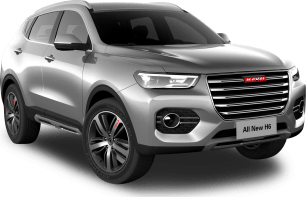Inoffensive but uninspiring is a blunt yet fair summation of the Haval H2 City's exterior design, especially when you think about rivals like the dramatic Toyota C-HR, edgy Hyundai Kona, or funky Mitsubishi Eclipse Cross.
The nose is dominated by a huge, slatted and chromed grille with bright metal mesh behind it, and vaguely Audi-of-10-years-ago shaped headlights either side.
The lighting treatment is elaborate with projector halogen main beams and reflector halogen high-beam units surrounded by a dotted-line string of LEDs looking uncomfortably like aftermarket inserts available via your online auction site of choice.
Standard fog-lights are recessed into a blacked-out area under the bumper, with another line of LEDs, functioning as DRLs, below that. And just to complicate matters, the upper LEDs only illuminate with the headlights, while the lower units come to life when the headlights are off.
A sharp character line runs along the H2's flanks from the trailing edge of the headlights to the tail, with an equally distinct swage line running from front to back, narrowing the car's mid-section and accentuating the bulge of its wheelarches, filled adequately by standard 18-inch multi-spoke alloy rims.
The rear is similarly reserved, the only hint of flash confined to a roof-top spoiler, cool typeface chosen for the prominent Haval badging across the hatch door, and a diffuser with chrome exhaust tips poking through either side.
Inside, the look and feel is early noughties plain, The dashtop is a nice soft-touch material, but there are lots of buttons and old-school analogue instruments combined with a media and ventilation interface that might have been acceptable on a mainstream model 20 years ago.
Don't even think about Android Auto or Apple CarPlay. The tiny LCD screen (sitting below a CD slot) wins the smallest, most basic graphics award. A miniscule scale reflecting the manual air-con's temperature setting is a particular low-light.
A small 3.5-inch screen between the tacho and speedometer displays fuel economy and distance information, but frustratingly no digital speed read-out. Standard cloth trim has a distinctly synthetic but tough feel, while the polyurethane plastic steering wheel is another throwback.
Sure, we're at the budget end of the market here, but be prepared for low-tech design combined with cheap and cheerful execution.

